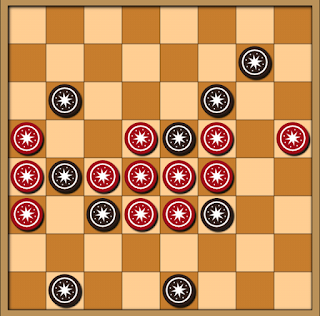About This Blog
This is a blog about the game Lines of Action, an abstract strategy game invented by Claude Soucie and published in Sid Sackson's A Gamut of Games in 1969. This blog is a response to the 100 Play Challenge set up by Nick Bentley on Board Game Geek, and most of the entries will be records and analysis of the games that I play as part of this challenge. But there might be analysis of other LOA games, random observations, guest posts, etc.
There are hundreds abstract of strategy games out there, but unfortunately very few with extensive literature (strategy guides, game records, blogs etc.) about them. Chess, Checkers, Go, Shogi and Xiang-qi come to mind. Other abstracts have maybe 1 or 2 guides in print, e.g. Hex, Othello, Hive, Arimaa etc. This blog is intended to expand the knowledge of LOA, and hopefully encourage others to write about their favorite, lesser known abstracts.
The graphics on this site will either be photos of my "set" (using a chess board and Gipf pieces) or pictures of the Lines of Action app, created by Pool Night Studios. My thanks to Pool Night for letting me uses their graphics.
Most of these games will be played with human opponents, either online or in person. I will play 16 games with the Pool Night app (4 games on each of 4 levels).
The game records will use long algebraic notation (e.g. 1.c8-c6 a2-c2 2. d8-b6 a6-c4)
If anyone wants to help me with this challenge, I play and boardspace.net and iggamecenter.com under the user name bebopj. Also, any comments on how to improve this blog are welcome.
Pieces can move in any orthogonal or diagonal direction, but they can only move the exact number of spaces as there are pieces (both yours and your opponents) in the particular row, column or diagonal. So if there are 3 pieces in row 4, any of those piece can move 3 squares within that row.
You may jump over your own pieces, but you cannot jump over your opponent's pieces. You can land on your opponent's pieces to capture them, but you can't land on your own pieces.
In the above position, red's piece on c5 can move 3 spaces to f5 or 2 spaces to either a7 or e3. All other moves are illegal.
If a player cannot make a move, they must pass. Some people play that if a player cannot make a move, it's a draw. A three fold repetition is a draw.
The object of the game is to connect all of your pieces, orthogonally and/or diagonally on the board.
Originally, a move which resulted in a winning position for both sides was considered a draw. Claude Soucie later changed this rule so that the player making the move wins the game.
If you make a move that results in a winning position for your opponent, then they win the game.
Lines of Action Rules
Lines of Action is played with a checkers set. The black checkers go on the top and bottom rows, minus the corners. The red checkers go on the left and right columns, minus the corners. Black goes first. (Note: on some websites, the colors are black & white or red & white. In these cases white always goes 2nd.)
 |
| Opening position |
In the above position, red's piece on c5 can move 3 spaces to f5 or 2 spaces to either a7 or e3. All other moves are illegal.
 |
| Winning position for black |
Originally, a move which resulted in a winning position for both sides was considered a draw. Claude Soucie later changed this rule so that the player making the move wins the game.
If you make a move that results in a winning position for your opponent, then they win the game.

























